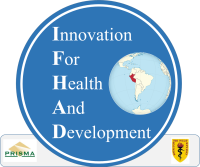Decreasing Transmission of TB in Hospital/Clinical Settings
Nosocomial MDRTB (Multi-drug resistant TB) transmission during DOTS (Directly Observed Treatment, short-course):
In Peru, TB is treated in DOTS clinics that require patients to attend for treatment several times a week. Research demonstrates that whilst patients with antibiotic-susceptible TB rapidly become non-infectious, DOTS requires them to regularly share the same airspace as MDRTB patients, many of whom remain infectious. Our study showed 6.3% (30/474) patients with an initial non-MDRTB diagnosis had MDRTB by the end of treatment. This change was associated with increased mortality.
Natural ventilatory protection against nosocomial TB transmission:
Dr. Rod Escombe who has been working with IFHAD in this area has demonstrated that the risk of TB transmission in hospitals and clinics can be greatly reduced by opening windows and door to maximize natural ventilation – a simple and yet highly effective strategy that is appropriate in much of the tropics (Escombe et al, PLoS medicine).
Dr Escombe has also determined the factors that influence and predict the infectiousness of TB patients in hospital (Escombe et al., Clinical Infectious Diseases). His recent work has demonstrated that UV lights and negative air ionizers can be used in patients’ rooms to kill the TB in the air, preventing person to person TB transmission. This work is being published in full and is described below in the following abstract that was presented at the November 2006 International Union Against TB & Lung Disease Conference:
Upper room ultraviolet light and negative air ionization both prevent airborne tuberculosis transmission.
Upper room ultraviolet light and negative air ionization both prevent airborne tuberculosis transmission:
A Roderick Escombe, David AJ Moore, Robert H Gilman, Marcos Navincopa, Eduardo Ticona, Rocio Ramirez, Bailey Mitchell, Carlos Martà nez, Luz Caviedes5, Patricia Sheen, Armando Gonzalez, Catherine Noakes, Jon S Friedland, Carlton A Evans.
Rationale: Institutional TB transmission is an important problem necessitating studies of environmental control measures.
Objectives: To evaluate upper room ultraviolet germicidal irradiation (UV) and negative air ionization for preventing airborne TB transmission.
Setting: A guinea pig facility sampling the air from a TB ward in Lima, Peru.
Methods: Exhaust air from the TB ward was passed through three enclosures each housing 144 guinea pigs. On alternate days, ward air was passed over ‘control animals’ and ‘ionizer animals’ (ionizers located within the guinea pig enclosure). On the other days, UV lights were turned on in the ward and ward air passed over ‘UV animals’. All guinea pigs had monthly tuberculin skin tests and positive reactors underwent autopsy and organ culture for TB.
Results: After 300 days there were 55 tuberculin-positives in the control animals, 26 in ionizer animals, and 15 in UV animals (P<0.001). Kaplan-Meier analysis of skin test data demonstrated that TB transmission was prevented by both ionizers (log rank 10.6; p=0.001) and UV lights (log rank 23.4; p<0.0001). Autopsy and culture results lag behind skin tests and currently provide borderline confirmatory evidence that UV is protective (log rank 3.6; p=0.057) in this ongoing experiment.
Conclusion: Despite high humidity in Lima, upper room UV lights and negative air ionizers both prevented most airborne TB transmission and these interventions should therefore be used in high-risk clinical settings.
